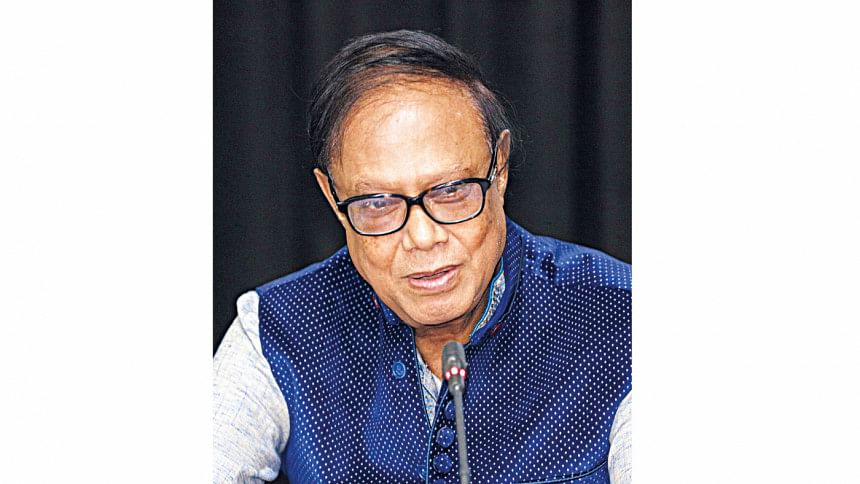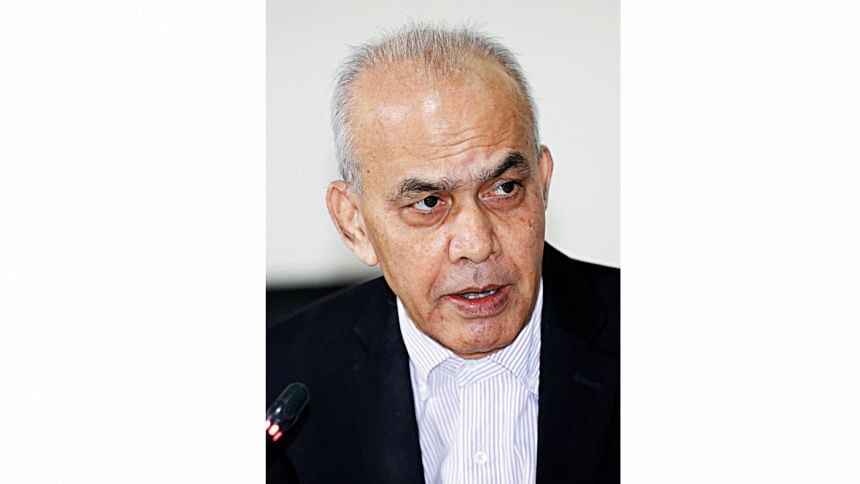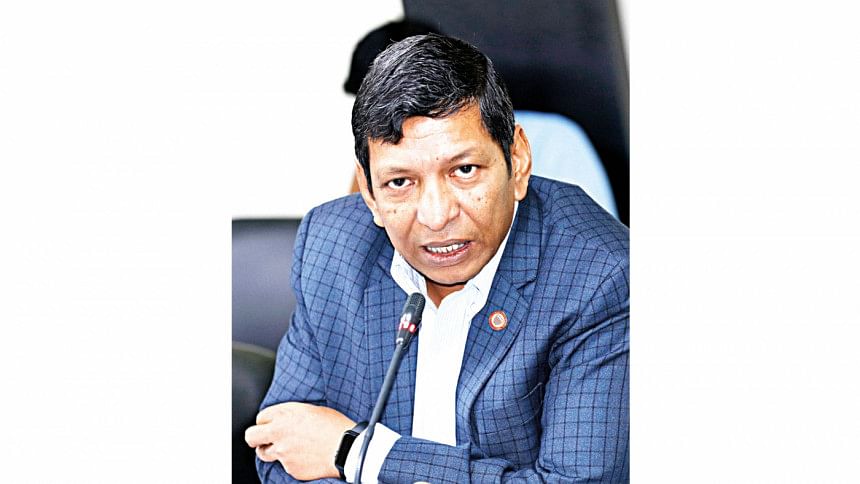The Future of Money: Central Bank’s Digital Currency

Policy Research Institute (PRI) in collaboration with The Daily Star organized a roundtable titled 'Future of Money' on March 31, 2024. Here we publish a summary of the discussion.

Dr Ahsan H Mansur, Executive Director, PRI
Over the past decade and a half, extensive research has been conducted on the topic across the globe by different central banks and researchers. Some countries have even embarked on trial runs. There's a palpable sense of cautiousness, with major central banks and governments waiting to see who will take the lead in launching digital currency at retail level. Several smaller countries have made strides, albeit with mixed success. It's clear that before making any decisions, we must closely examine the experiences of others.
Infrastructure development, particularly in terms of technology upgradation, is imperative. This includes internet-based systems, networking, and cybersecurity. Bangladesh Bank must also strategize for potential future scenarios. The Reserve Bank of India has made significant progress in their research on digital currency, though implementation still remains far off. The silence from the Chinese government adds to the intrigue, especially considering their successful city-level trials.
Inevitably, the digital currency will become global in future. However, the pros and cons are myriad. While its introduction can combat corruption, it also poses political economy risks towards its effective introduction, particularly if corruption is ingrained within bureaucratic structures and political system. Privacy concerns also persist as financial data becomes more accessible. In balancing efficiency with state mechanisms and regulatory hurdles, we must foster innovation while safeguarding individual rights to privacy.

Dr M A Razzaque, Director, PRI
The study has been led by PRI in association with The Bill and Melinda Gates Foundation, with primary missions of enhancing financial literacy and fostering financial inclusion. In this journey, PRI actively engage in policy research and contribute in advocacy. The feasibility assessment of digital currency by central bank mentioned in budget of fiscal year 2022-23 worked as a drive behind commencing of this paper.
Undoubtedly, CBDC (Central Bank's Digital Currency) marks a pivotal innovation, shifting from physical currency to digital wallets. Understanding its dynamics and implications is paramount in today's monetary landscape. Cost savings are significant compared to traditional printing, as digital security measures complicate counterfeiting. Tracking transactions becomes easier, reducing the cost of combating forgery.
CBDC paves the way for a cashless society, enhancing transparency and combating corruption. However, our paper advocates for a balanced approach, promoting coexistence of digital currency and physical cash to capitalize on benefits while gradually transitioning towards a cashless economy.
CBDC differs from cryptocurrencies. While cryptocurrencies such as Bitcoin and Ethereum operate privately and face varying legal statuses depending on the country, however CBDC functions similarly to traditional money, holding solid legal backing. Bangladesh, for instance, has explicitly stated its disavowal of Bitcoin and prohibited Bitcoin transactions within its jurisdiction. Cryptocurrency's speculative trading nature leads to high volatility, whereas CBDC, not intended for trading, remains stable. Though subject to periodic fluctuations, akin to monetary policy effects like inflation, CBDC maintains overall stability.
Digital currency manifests in two main forms: Wholesale CBDC, facilitating bank-to-bank transactions with distinct regulations, and Retail CBDC, providing digital currency directly to individuals.
it's important to note that cryptocurrency operates on blockchain technology, which can also serve as the foundation for CBDC. Ensuring a reliable storage system including cloud-based storage or physical storage systems, is crucial for recording every transaction and maintaining data integrity. An accessible interface can be established through web-based platforms, mobile applications, or computer interfaces.
Transactions can be easily traceable in CBDC making the approach transparent albeit at a potential cost of privacy. In contrast, cryptocurrencies like Bitcoin, uses complex technology to give a maximum protection to privacy with one of its adverse impacts being facilitating transactions that may be deemed illegal or inappropriate.
There are two principal sources of information on CBDC research and adoption. The Atlantic Council, which is an American think tank in the field of international affairs, reports that three countries have already launched their digital currencies and 36 countries are in the pilot stage, whereas according to CBDC Tracker—a collaborative initiative of Boston Consulting Group, Ernst & Young, Digital Euro Assocation—four central bank digital currencies are already in operation with 46 countries are in the pilot and proof of concept stages. Despite the differences between specific details, both the sources show that there are more than 100 central banks globally that are either researching or in the process of piloting CBDCs.
Notable CBDCs that are in operation include Jamaica's JamDex, Nigeria's eNaira, and the Bahamas' Sand Dollar. On the other hand, Ecuador and the Philippines are examples of countries that have either canceled or backtracked their digital currency projects. The world's largest CBDC pilot is being conducted by China. Its digital yuan (e-CNY), reached 260 million wallets in 26 cities in 17 provinces. In recent years, digital yuan has been experimented in various sectors, from transportation and healthcare to purchasing crude oil. India is also seriously pursuing its CBDC project with the Reserve Bank of India (RBI) planning to introduce the ability to conduct offline transactions using its digital rupee (e-Rupee) as part of its CBDC pilot. This functionality aims to enable transactions in areas with limited or no internet connectivity, expanding the digital rupee's accessibility and practicality. The United States appears to have a cautious approach to CBDC.
Some countries are also exploring options for using CBDCs for cross-border transactions. For instance, Project Jura is a collaboration between the central banks of France and Switzerland, along with the Bank of International Settlements (BIS), for the settlement between two wholesale CBDCs. Similarly, the mBridge Project involves the BIS and the central banks of China, Hong Kong, Thailand, and the UAE, aiming to establish a multi-CBDC platform that improves cross-border payments and foreign exchange transactions by using distributed ledger technology for more efficient transactions.
From the experiences of the countries that have adopted CBDCs, it seems that there has been an uptick in digital wallet registrations and usage although the progress towards a cashless economy remains an objective for the future.
CBDCs hold significant promise, particularly for financial inclusion, through instant money transfers to remote regions; faster, cheaper and simplified transactions; strengthened central bank's influence over monetary policy. However, several challenges remain. Digital infrastructure, especially internet access, cybersecurity deficiencies, and digital literacy gaps continue to impede progress. Updating digital infrastructure and policies on data storage and privacy concerns are essential steps. Pilot programmes, such as paying government workers with digital currency, can offer valuable insights for future implementation.There are important lessons for Bangladesh in CBDCs. Firstly, given the widespread global interest in digital currency, it's essential for us not to remain on the sidelines. Secondly, the pace of CBDC adaptation appears to be slow and thus achieving quick gains by introducing a CBDC is not to be expected. Thirdly, transitioning to CBDC doesn't necessitate an immediate shift to a cashless society; instead, gradual progress is more realistic and effective.
Bangladesh Bank must intensify research and exploration into CBDC technology. Identifying innovation opportunities and conducting small-scale experiments can enhance understanding of digital currency potential.
Lastly, the utmost priority lies in strengthening our national capacity. Without advancements in institutions, infrastructure, and regulatory frameworks, digital currency initiatives will falter, and other service systems like DFS and MFS will also struggle to thrive. Focusing on improving overall infrastructure and literacy is imperative for progress and avoiding digital gap led inequality.

Dr Jamaluddin Ahmed, FCA, Chairman, Emerging Credit Rating Limited
Transitioning to digital currency mandates a skilled workforce, yet our bureaucratic structures, deeply entrenched in analog practices, pose formidable barriers to this transformation. Unlike many countries actively researching and piloting digital initiatives, Bangladesh has lagged due to its adherence to traditional systems. However, it's essential to recognize that such evolution will take time but should not be unduly prolonged.
While our existing payment systems, including MFS, have served us adequately, their limitations are evident. It's evident that both the operators of such platforms and our regulatory bodies lack sufficient expertise in this domain. Therefore, our primary focus should be on providing comprehensive training to empower them for optimal performance in this evolving landscape.
Sweden, a cashless pioneer, faces central bank digital currency dilemmas. Despite global prominence, it cautiously navigates decisions, offering valuable insights. In democratic settings, safeguarding rights and privacy is paramount.
Seminars needed to clarify confusion on cryptocurrency, digital currency, and MFS distinctions, essential for better understanding and dissemination of knowledge. Regulators, including NBR overseers, need trainings to initiate appropriate approaches. Additionally, urgent modernization required for transitioning NBR to digital system.
Given the printing cost of physical currency, for every BDT 100, it costs BDT 3, with the remaining constituting profit. Thus, if the central bank were to adopt digital currency, what potential issues might arise?

M Sabbir Hossain, DMD and Chief Operating Officer, Brac Bank
The emergence of Bitcoin and Facebook's Libra, coupled with Mark Zuckerberg's ambitious plans for Libra, spurred active engagement from central banks and relevant bodies worldwide. While Bitcoin presented promising aspects, concerns about its adverse effects became apparent. It's crucial to maintain a safe distance from potentially harmful cryptocurrencies like Bitcoin, making CBDCs a viable solution to effectively address and mitigate such risks.
The lack of infrastructure for conducting pilot projects for CBDCs poses a significant obstacle. Despite this, there's acknowledgment that a completely regimented approach to CBDC implementation may not be suitable for Bangladesh. As mentioned by our deputy governor in Barishal, transitioning to a cashless system could potentially enrich the economy by more than 1.27 percent in GDP growth. However, achieving 100 percent cashlessness remains unrealistic.
Today, we're inaugurating the Astha App, facilitating monthly transactions worth 10,000 crore through 20 lakh transactions. This achievement is remarkable, considering we've transitioned from zero to such substantial digital transactions in just three years. It's imperative to highlight the substantial volume of transactions through MFS, underscoring our progress towards a cashless society.

Aminul Haq, Director, Chief Executive Officer (Acting) & CFO, Nagad
Before introducing CBDC in Bangladesh, it's crucial to address the significant reliance on cash transactions. Currently, the prevalence of cash-in and cash-out transactions exceeding 1000 crore in our MFS indicates that we haven't fully transitioned this substantial volume into digital transactions. Establishing an ecosystem based on cashless transactions is imperative before implementing CBDC in Bangladesh. While countries like China and others have embraced cashless transactions, the Philippines' lack of a centralized KYC system presents challenges due to its geographic division. However, Cambodia's successful pilot of CBDC could serve as an example for Bangladesh.
Collaboration between Thailand and Hong Kong on cross-country settlement offers another avenue to address our remittance challenges, especially with a significant number of Bangladeshi workers in Malaysia. Notably, Nagad has received a digital banking license, positioning itself to lead in this sector. However, reliance on foreign companies due to a shortage of skilled manpower in Bangladesh underscores the need for investment in local talent to navigate the complexities of the financial system effectively.

Arif Rahman, Manager, MicroSave Consulting
The concept of CBDC and cryptocurrency is relatively new in the context of Bangladesh. While digital money was introduced around 10 to 12 years ago, the idea of digital currency dates back to 1983 and has been rapidly gaining traction. My focus has been on studying human behavior and adaptation, particularly in relation to digital money and financial services. If these cryptocurrencies are backed by the central bank, they could find utility in various sectors such as companies, remittances, and international transactions. However, the level of adoption among the general population is a crucial consideration. Despite the significant presence of MFS, many individuals still prefer traditional cash-in and cash-out transactions, valuing the tangibility of physical currency.
Issues such as network reliability and infrastructure pose challenges to the widespread adoption of digital money. Therefore, any proposed system or policy ultimately hinges on how well it is embraced by users. There is immense potential to raise awareness among the public about the evolving nature of financial systems. However, it's equally important to understand and address the behavioral factors that influence users' attitudes and preferences towards digital transactions.

Dr Ashikur Rahman, Senior Economist, PRI
Like every technological innovation, CBDC can cut both ways. In developing countries, commercial banks are primarily responsible for processing savings into investments. Therefore, if CBDC aims to directly connect individuals with the central bank – who will process savings into investments? The commercial banks are not only instrumental in screening potential investors who can effectively use the deposited savings, but it has been the only dominant mechanism of supporting large private sector investments in Bangladesh. Therefore, it is not clear how we can open such a technological window without hurting commercial banks, which complicates how CBDC will actually influence economic growth.
Furthermore, we have to be careful about the political economy concerns. If misused, CBDC can be used to violate economic freedom of individuals, which can empower authoritarian polities.
Open Discussion
Dr Jamaluddin Ahmed, FCA, Chairman, Emerging Credit Rating Limited
After the central bank's transition to digital currency, the roles of MFS and the overall banking system will remain distinct. There is no need for confusion in this matter. The central bank will not engage in lending activities; its function is to support the government in managing the economy as needed. This fundamental role will not change. Commercial banks will continue their operations and will likely become more digitalized, leading to a reduction in transaction costs.
MFS won't become obsolete; their relevance persists. Debit and credit card services may face challenges with service charges compared to MFS. Platforms like bkash, Nagad, and Roket are poised to expand in this evolving landscape.
Dr Ahsan H Mansur, Executive Director, PRI
Regardless of whether we shift towards digital currency or not, digitized transactions are inevitable and unquestionably necessary. We must develop our digital infrastructure and strive for 100% digital outreach and a cashless society.
Even with digital currency, many safeguards should be incorporated to ensure the principles and values of democracy. We must address these issues thoughtfully.
Finally, we need to assess how beneficial the digital currency will be for Bangladesh. If we can achieve a cashless society, we go a long way toward the efficiency gains out of digital currency. We must consider our social and political context when evaluating its potential contributions. I believe the civil society and Bangladesh Bank should collaborate to advance these safeguards and, the efficiency of digital infrastructure further.
If the infrastructure is ready, digital currency can be compatible with any technological advancements. Currently, central banks are at innovation stages, indicating that they would initially implement CBDC within the commercial bank structures. They do not intend to replace commercial banks at this stage. For instance, if Bangladesh Bank plans to disburse 5,000 crore Taka in digital currency, it will do so through the commercial banks.

Arun Dev Nath, Deputy Editor, The Daily Star
The possibility of cross-border transactions using digital currency is crucial to notice. The way the dollar has dominated against other developing countries' currencies raises hope. This could be a compelling argument for us to present to the government and the central bank, as it seems like an area where they may see the need for action.
For instance, consider a recent example where Bangladesh struggled to pay Russia at least 400 US dollars due to sanctions. In such cases, exploring options like using yuan or digital currencies from specific digital banks for transactions could be promising. However, this is just speculation, and there's still a long way to go.

Tanjim Ferdous, In-charge of NGO and Foreign Missions, Business Development Team, The Daily Star & Moderator of the session
As we stand on the brink of a digital revolution, the inevitability of digital currency becoming a global phenomenon is undeniable. This shift promises to combat corruption and streamline transactions, yet it also introduces a complex array of challenges. Today, we have delved into a comprehensive discussion of both the positive and negative aspects of this issue. It is crucial that we continue this dialogue, as we can no longer ignore the reality of the digital transformation within our currency system. Together, we must navigate this new landscape, addressing both its opportunities and its risks.
Recommendations
- The costs of combating counterfeiting in traditional money can be drastically reduced with the introduction of digital currency equipped with utmost security.
- Increasing adoptability and knowledge among the public is vital.
- Conduct a meta-analysis before launching CBDC pilot programs to avoid blindly replicating other countries' pilots.
- Increased investment in local manpower, digital literacy, and understanding financial behavior is essential.
- Assess how digital currency can benefit us, aiming for transparency in a cashless society, while considering our social and political context.
- Promote collaboration between civil society and the Bangladesh Bank to address challenges and opportunities in digital currency adoption, fostering informed decision-making and public awareness.
- Using digital currencies for cross-border transactions to address challenges like currency dominance and sanctions, enhancing financial flexibility and resilience for developing countries.
- The importance of public sector involvement in infrastructure development to foster financial inclusion is paramount.
- Bureaucratic barriers in analog practices hinder Bangladesh's transition to digital currency, necessitating comprehensive reforms.
- Navigating a gradual transition rather than a sudden leap towards a cashless society is imperative.

 For all latest news, follow The Daily Star's Google News channel.
For all latest news, follow The Daily Star's Google News channel. 



Comments